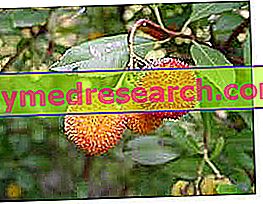Introduction
Imagine a sort of giant cherry, with yellow and fleshy pulp, with a grainy surface covered with rigid tubercles: it is under this garment that the strawberry trees, fruits of the homonymous plant known in botany as Arbutus unedo, appear. In the spoken language, the strawberry tree is also famous as an albatross : it is a small tree or, better to say, a bush, belonging to the same family as the bilberry, the Ericaceae.

Analysis of the term
Like innumerable plant names, the strawberry tree also derives from ancient Greek: precisely, the archaic term is κόμαρος and it is from this name that, over the years, many more and more dialectal names derived from the strawberry tree were derived.
Generality
The strawberry tree has a very ancient origin: so much so that it is even mentioned in a passage of the Aeneid.
Although the strawberry tree is native to the Mediterranean maquis, over the years it has spread to the Nordic regions, even reaching Ireland.
The plant is often cultivated for ornamental use, given its decorative peculiarity; however, the fruits are edible and their use has long been known in phytotherapy, thanks to the astringent and, above all, disinfectants of the urinary tract.
Botanical description
In the botanical nomenclature, the arbutus is Arbutus unedo : the plant in question is a very branched evergreen shrub, both cultivated and tamed. It can assume heights varying from one to eight meters. The strawberry tree is characterized by leathery, glossy, oval and very large leaves (length: 10-12 cm, width 2-4 cm), with serrated and irregular margins.
The flowers, very particular and bell-shaped, are gathered in hanging panicles; as we have already analyzed, the flowers are white, sometimes pink, and pour out very small teeth, an unmistakable characteristic.
The anthers of the arbutus flowers attract many bees to themselves because they are very rich in nectar: the problem is represented by the period of flowering, between October and November, when bees are not always active. However, the honey obtained has a delicate taste, with a particular bitter note.
The arbutus plant blooms and bears fruit at the same time: this joke of Nature is explained by the fact that the fruits derive from the flowers of the previous vintage [taken from Dizionario ragionato of herbal medicine and phytotherapy, by A. Bruni, M. Nicoletti]
The fruits, red and big as a cherry, have yellow flesh and a tuberculous surface.
Chemical analysis and properties
The strawberry tree boasts numerous properties, most of which are attributed to tannins, which constitute a rather consistent quantity: in this regard, the strawberry tree is used in phytotherapy as a disinfectant of the urinary tract. The extract is also characterized by arbutin, a hydroquinone glucoside that lends itself perfectly to the treatment of cystitis and urinary inflammation in general. However, in arbutus the arbutin content, compared to that of the bearberry, is decidedly lower.
Only recently, some components have been isolated in the strawberry tree: iridoid gardenoside and asperuloside.
The phytocomplex extracted from the strawberry tree ensures disinfectant, strongly astringent and diuretic (bland) properties. In phytotherapy, the use of arbutus in the form of an infusion is recommended in case of intestinal inflammation. The use of mother tincture in prostatic and urethral affections is generally accepted: it seems, in fact, that the arbutus mother tincture is capable of interrupting the cascade of events that feed urethritis, thus favoring the repair of the urethral mucosa.
It is imperative not to exceed the doses: an immoderate use of arbutus and products based on the same, can cause damage to the gastrointestinal level. As with all herbal products, the strawberry tree can also interact with drugs: in this regard, it is advisable to tell the doctor or herbalist which pharmacological substances are being taken.
Summary
Strawberry tree: to fix the concepts ...
| Strawberry tree: nomenclature | Common name: arbutus, albatross Botanical name: Arbutus unedo |
| Strawberry tree: origin of the term | "Corbezzolo" derives from the ancient Greek (κόμαρος), a term from which derived a multitude of dialectal nicknames over the years |
| Strawberry tree: symbolism | Strawberry tree → Tricolor: white flowers, green leaves and red fruits |
| Strawberry tree: fruit | Comparable to a giant cherry with yellow flesh and a grainy surface covered with rigid tubercles |
| Strawberry tree: general characters | Origin: Mediterranean maquis Current spread: Northern regions, Ireland Uses: ornamental-decorative, food, herbal medicine |
| Strawberry tree: botanical description |
|
| Strawberry tree: chemical analysis of the components | Tannins Arbutin (hydroquinone glucoside) Iridoids: gardenoside and asperuloside |
| Strawberry tree: medicinal properties |
|
| Strawberry tree: contraindications | Inordinate use → gastrointestinal damage Possible drug interactions |



